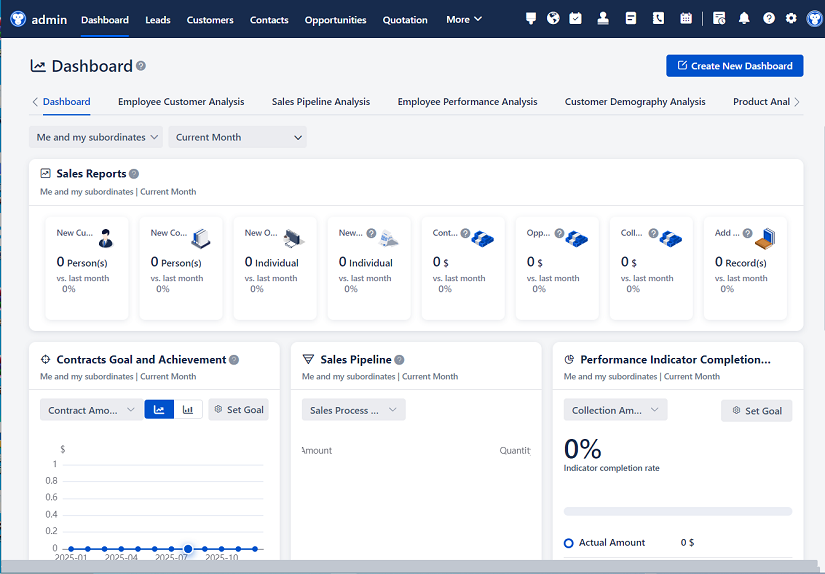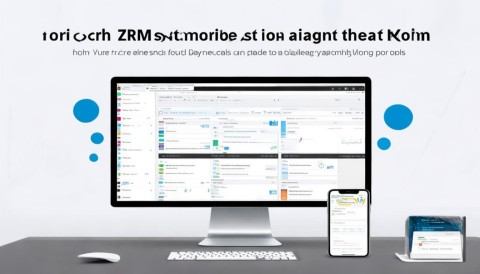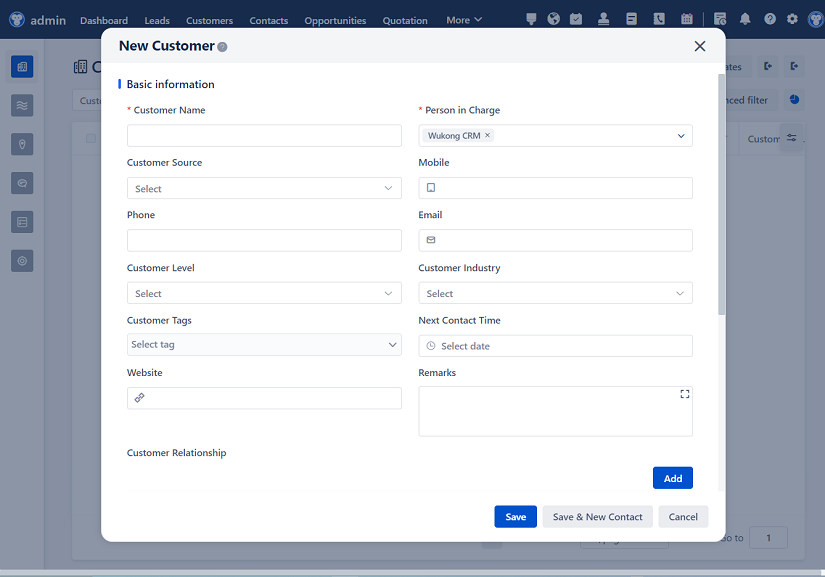
△Click on the top right corner to try Wukong CRM for free
So, let me tell you something—I’ve been spending a lot of time lately looking into CRM software. You know, the kind of tools that help businesses manage customer relationships, track sales, and keep everything organized. Honestly, it’s kind of overwhelming how many options are out there. I mean, every company seems to have their own version these days—some flashy, some simple, some promising the moon. But after digging in for weeks, comparing features, pricing, user reviews, and real-world usability, I think I’ve got a pretty solid handle on what’s actually worth your attention.
First off, let’s talk about Salesforce. Yeah, I know—it’s like the big name everyone brings up first. And honestly, there’s a reason for that. It’s powerful, super customizable, and used by tons of major companies around the world. But here’s the thing: it’s not exactly beginner-friendly. I tried setting up a basic workflow once, and man, it took me hours just to figure out where half the buttons were. The interface feels… cluttered, you know? Like they added so many features over the years that it’s become a bit of a maze. Still, if you’ve got a dedicated team or an IT department that can handle the complexity, Salesforce is definitely a beast when it comes to functionality.
Free use of CRM system: Free CRM

Then there’s HubSpot. Now, this one? I really liked it. It felt way more intuitive right from the start. I signed up for the free version just to test it out, and within 20 minutes, I had contacts imported, emails set up, and a basic pipeline running. That’s huge. Plus, their marketing tools are baked right in, which makes sense because HubSpot started as a marketing platform. So if you’re a small business or even a growing startup trying to do both sales and marketing from one place, this could be perfect. Oh, and their customer support? Super responsive. I messaged them with a question at 9 PM on a Tuesday, and someone got back to me in under ten minutes. Not bad.

But let’s not forget about Zoho CRM. This one surprised me. I’ll admit, I didn’t expect much at first—kind of thought it was just another budget option. But nope. Zoho has seriously stepped up its game. The UI is clean, the automation tools are solid, and the pricing? Way more affordable than Salesforce or even HubSpot when you start scaling up. I also love that they offer a ton of integrations without making you pay extra for each one. For example, connecting to Gmail or Outlook is seamless, and their mobile app actually works well—something a lot of CRMs mess up.

Now, Microsoft Dynamics 365 is another player in this space, and I have mixed feelings about it. On one hand, if your company already uses Microsoft 365—Outlook, Teams, SharePoint—you’re going to love how smoothly it integrates. Everything just clicks together. But on the other hand, it feels a little… corporate? Like, it’s built for big enterprises with deep pockets and armies of consultants. Setting it up isn’t something you can just do over a weekend. And the learning curve? Steeper than I’d like. Still, if you’re in a large organization and need something that plays nice with Microsoft’s ecosystem, it’s definitely worth considering.
Freshsales, now part of Freshworks, is another one I spent some time with. What stood out to me was how AI-driven it is. It automatically scores leads based on behavior, suggests the best times to follow up, and even transcribes calls. That’s kind of cool, right? I tested the voice assistant feature during a mock sales call, and it actually picked up key points and created notes for me. Pretty impressive. The interface is modern and easy on the eyes, and their pricing tiers are transparent. No hidden fees, which I appreciate. It’s especially good for sales teams that want smart insights without drowning in data.
Pipedrive is another favorite among smaller sales teams. I remember talking to a friend who runs a boutique agency, and he swears by it. He said it helped him double his conversion rate in six months. When I checked it out, I could see why. Pipedrive focuses heavily on the sales pipeline—like, really emphasizes visualizing each stage of the deal. It’s drag-and-drop friendly, super simple to use, and doesn’t overwhelm you with unnecessary features. If your main goal is to close more deals and keep your process visible, this might be your go-to.
Then there’s Monday.com—wait, isn’t that a project management tool? Well, yeah, but they’ve expanded into CRM territory too. I was skeptical at first, but after using it for a few weeks, I realized it’s actually pretty flexible. You can customize workflows to act like a CRM, add customer fields, track interactions, all within their visual board system. It’s great if your team already uses Monday for other tasks and wants to keep everything in one place. But—and this is a big but—it’s not a true CRM out of the box. You’ll need to spend time setting it up properly, and even then, it might lack some of the deeper sales analytics that dedicated CRMs offer.
One thing I noticed across all these platforms is how important integration is. Like, no matter how good a CRM is, if it doesn’t play well with your email, calendar, or other tools, it’s going to cause headaches. That’s why I paid close attention to how easily each one connected with common apps. HubSpot and Zoho nailed this. Salesforce does too, but only if you’re willing to pay for the connectors. Some others? Not so much. I tried linking a lesser-known CRM to my Google Calendar once, and it took three separate support tickets to get it working. Not fun.
Another big factor? Mobile experience. Let’s be real—we’re not always at our desks. Salespeople are on the go, meeting clients, hopping between calls. So having a CRM that works well on a phone is crucial. HubSpot and Freshsales have excellent mobile apps. Clean design, fast loading, full functionality. Zoho’s is decent, but a bit clunky. Salesforce’s mobile app? Honestly, I gave up after five minutes. Too many menus, too slow. If you rely on your phone for work, test the mobile version before committing.
Pricing is always a touchy subject. I get it—budgets are tight, especially for small businesses. Salesforce can cost hundreds per user per month once you add all the bells and whistles. HubSpot starts free but gets expensive fast as you scale. Zoho and Freshsales are much more budget-friendly, with robust features even on lower tiers. Pipedire is mid-range—not cheap, but fair for what you get. My advice? Don’t just look at the sticker price. Think about what you actually need. Paying $300/month for features you’ll never use is just throwing money away.
User adoption is another thing people don’t talk about enough. I’ve seen companies invest in a fancy CRM only to have their team ignore it because it’s too complicated. That’s a waste. A CRM is only as good as the data in it, and if your team isn’t using it consistently, you’re not getting value. That’s why ease of use matters so much. HubSpot and Pipedrive win here because they’re designed with the end-user in mind. Salesforce? Great power, but only if people actually use it.
Customer support varied a lot too. Some companies offer 24/7 live chat and phone support. Others make you submit a ticket and wait days. HubSpot and Freshsales were top-notch. Zoho was okay—decent response time, but sometimes generic answers. Salesforce support? Only if you’re on a high-tier plan. Otherwise, good luck. I ended up watching YouTube tutorials just to fix a syncing issue. Not ideal.
Let’s talk about customization. Salesforce lets you build almost anything—custom objects, workflows, triggers, you name it. But again, you need technical skills or a developer. HubSpot allows some customization through their “operations hub,” but it’s not as deep. Zoho strikes a nice balance—plenty of options without requiring coding. Pipedrive keeps it simple, which is fine if you don’t need complex setups.
Reporting and analytics are critical. How else do you measure success? All the CRMs I tested offered dashboards, but the quality differed. Salesforce has incredibly detailed reports—if you can figure out how to build them. HubSpot’s reports are easier to generate and look better visually. Freshsales gives real-time insights with AI suggestions, which I found super helpful. Zoho’s reporting is solid but a bit dry. Pipedrive’s is basic but gets the job done for small teams.
Security is non-negotiable. I checked each platform’s compliance—GDPR, SOC 2, etc.—and most of the big names passed with flying colors. Salesforce and Microsoft lead here, given their enterprise focus. HubSpot and Zoho also take security seriously, with regular audits and encryption. Smaller players? I’d do more homework before trusting them with sensitive customer data.
Finally, scalability. Can the CRM grow with your business? Salesforce wins hands-down. It’s built for global enterprises. HubSpot scales well too, especially if you’re using their full suite. Zoho offers a whole ecosystem of apps, so you can expand later. Pipedrive and Freshsales are great for SMBs but might hit limits as you grow.
So, what’s the verdict? There’s no one-size-fits-all answer. If you’re a small team wanting simplicity and affordability, go with HubSpot or Pipedrive. Need deep customization and have the resources? Salesforce. Want strong AI and modern tools? Try Freshsales. On a tight budget but still need power? Zoho’s your friend. Already in the Microsoft world? Dynamics makes sense.
It really comes down to your specific needs, team size, budget, and tech comfort level. I’d suggest starting with a free trial—most of these offer one—and testing it with your actual workflow. See how it feels. Ask your team for feedback. Because at the end of the day, the best CRM isn’t the fanciest one—it’s the one your team actually uses and benefits from.
FAQs (Frequently Asked Questions):
Q: Which CRM is best for small businesses?
A: I’d say HubSpot or Pipedrive. They’re easy to use, affordable, and packed with features that small teams actually need.
Q: Is Salesforce worth the high price?
A: Only if you need its advanced capabilities and have the team to manage it. For most small to mid-sized businesses, it’s overkill.
Q: Can I switch CRMs later if I change my mind?
A: Yes, but it can be a pain. Make sure to export your data properly and check if the new CRM offers migration tools.
Q: Do any CRMs offer a free plan?
A: Yep—HubSpot has a solid free tier, and Zoho CRM also offers a free version for up to three users.
Q: How important is mobile access?
A: Super important, especially if your team works remotely or meets clients in person. Always test the mobile app before deciding.
Q: Are AI features in CRMs actually useful?
A: In some cases, yes. Freshsales and HubSpot use AI well—for lead scoring, email suggestions, and call insights. But don’t expect magic.
Q: What should I prioritize when choosing a CRM?
A: Start with ease of use, integration with your current tools, and pricing. Then consider scalability and support.
Related links:
Free trial of CRM
Understand CRM software

△Click on the top right corner to try Wukong CRM for free